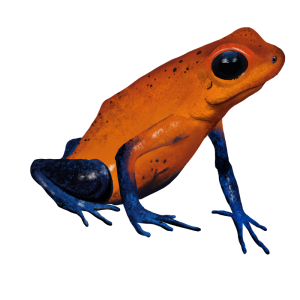By Annemarie Silkens
Many people are a bit creeped out by vultures because of their specific appearance and the fact that they eat cadavers. However, vultures are indispensable to nature; they are real cleaners. Read all about vultures and why they are indispensable to the ecosystem here.
(more…)
In July we told about the expansion of Adopt Rainforest’s reserve through the purchase of 48.5 acres of land. This parcel is very important because it forms a land bridge between the foundation’s current reserve and Barbilla National Park. Much of the new plot is existing forest, but there are also several acres of pasture […]
By Zoë Schreurs
In Costa Rica, you can’t ignore them: the Oophaga pumilio. Pumilio means dwarf, and although they are barely 3 cm tall, it is hard to miss the poisonous strawberry frogs. In English, they are called Strawberry Poison Dart frogs because indigenous peoples used to use their poison to makepoison darts. They are also affectionately called the “blue jeans frog,” because they often look like red frogs in jeans. Although they are by no means all the same colors. There are some that are completely red or blue, rather yellow, green or orange, or with black stripes or dots. In total, there are some 15 to 30 color variations.
(more…)
The mantle howler monkey is one of the largest monkeys in Central America, with males reaching a height of nearly a meter and a weight of up to 10 kg. It is one of 15 species of howler monkeys. Unfortunately, some of those species are endangered, mainly because of habitat loss and capture, for instance […]
Anyone who has traveled through the Americas knows them anyway, a stream of ants all carrying leaves with them. It looks like a mini highway that can go on for 30 meters. We’re talking about leaf-cutter ants of course. For tourists a source of amazement, for local farmers and vegetable gardeners a real plague that […]
My youngest daughter Iris is studying Applied Biology in Den Bosch. I visited her at her internship site in Costa Rica, where she stayed for 5 months. I am writing a piece about this because in addition to visiting my daughter, I had the opportunity to provide first aid training for the foundation’s staff and […]
In recent years, the reserve of the Adopt Rainforest Foundation has been easy for project manager Maarten to oversee. Two or three times a week he and the students make his rounds through the project area for the biodiversity research. For this research they visit several plots of the area, giving them a good insight into what is happening. Should any illegal logging occur, it is immediately noticed. The same goes for illegal hunting. In addition to the local presence, camera traps are hung at various places in the reserve. These are checked weekly. Should hunters or poachers walk through our reserve, this is quickly noticed.
(more…)
Despite uncertain economic times and the impact of Corona, the Foundation has some fantastic news to report. Over the past few months, we had to pull out all the stops and negotiate hard to acquire an important piece of land. And we succeeded! We were able to expand the reserve by 65 hectares, or 650,000 square meters!
(more…)
Costa Rica, a country of which almost half is rainforest, is a true birding paradise. More than 900 species of birds can be found here. One of the most beautiful and special birds that has its habitat in Costa Rica, however, is the Resplendent Quetzal. A good reason to go bird watching in Costa Rica!
(more…)
The world’s largest rainforests
It’s World Rainforest Day today (June 22)! A day to put our world’s rainforests in the spotlight because it’s mega important to protect them. Do you know which are the largest rainforests in the world? In this blog we will show them to you. We start at spot 10. (more…)
What is deforestation anyway? This term is used to describe the process by which trees give way to agriculture and livestock. Deforestation takes place in large numbers every day, especially in the Amazon rainforest. Not a pretty thing! The consequences? Cutting down trees not only means loss of our beautiful nature and biodiversity. It has an effect on the ambient temperature: it rises. This increase is caused by burning trees and because oxygen (O2) gives way to carbon dioxide (CO2) emissions. Trees store a lot of CO2 and this is released during deforestation. The numbers? Don’t be alarmed: around 13 million hectares of forest disappear on Earth every year, according to the FAO. To make it a little more tangible: this equals 18,207,280 football fields. Approximately 34 soccer fields per second! (more…)
